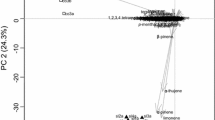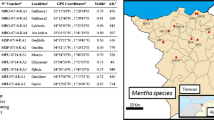Abstract
The antifungal potency of the essential oils of Rhanterium adpressum was evaluated against four mycotoxigenic strains of the genus Fusarium. The essential oils were obtained, separately, by hydro-distillation of the aerial parts of R. adpressum (leaves and flowers). The parts were collected during the period of bloom (3 months) for 3 years. The GC–MS analysis revealed thirty-six compounds for the essential oils, divided into four classes of chemical compounds, with variable percentages according to the month of extraction. The monoterpene hydrocarbons form the main class in these oils. On the other hand, the highest percentages of the oxygenated compounds are observed in the samples collected during the month of May. The direct contact method was used to evaluate the antifungal activity of the essential oils. The activity can be attributed to their relatively high composition of oxygenated monoterpenes. Flowers extract showed strong inhibitory activity, with very interesting concentrations of IC50 and MIC for both tests on solid and liquid medium. The effect of these oils on the production of type B trichothecenes (TCTBs) was evaluated, showing a significant inhibitory effect on TCTBs production, for both extracts (leaves and flowers). The rates of inhibition were 66–97 and 76–100% of FX, 3-ADON and 15-ADON, respectively. The inhibition of fungal biomass and the production of TCTBs depended on the used concentration of the essential oils. These results suggest that the essential oils from R. adpressum are able to control the growth of the tested strains and their subsequent production of TCTB mycotoxins.






Similar content being viewed by others
References
Adams RP (2007) Identification of essential oil components by gas chromatography/mass spectrometry, 4th edn. Allured Publ. Corp, Carol Stream
Amvam Zollo PH, Biyiti L, Tchoumbougnang F, Menut C, Lamaty G, Bouchet P (1998) Aromatic plants of tropical Central Africa. Part XXXII. Chemical composition and antifungal activity of thirteen essential oils from aromatic plants of cameroon. Flavour Fragr J 13:107–114
Bajpai VK, Shukla S, Sharma A (2013) Essential oils as antimicrobial agents. In: Rramawat KG, Merillon JM (eds) Natural products. Springer, Berlin, Heidelberg, p 3975–3988
Bakan B, Pinson L, Cahagnier B, Melcion D et al (2001) Toxigenic potential of Fusarium culmorum strains isolated from French wheat. Food Addit Contam 18(11):998–1003
Benzo M, Gilardoni G, Gandini C et al (2007) Determination of the threshold odor concentration of main odorants in essential oils using gas chromatography–olfactometry incremental dilution technique. J Chromatogr A 1150(1–2):131–135
Böhme K, Barros-Velázquez J, Calo-Mata P, Aubourg SP (2014) Antibacterial, antiviral and antifungal activity of essential oils: mechanisms and applications. In: Villa T, Veiga-Crespo P (eds) Antimicrobial compounds. Springer, Berlin, Heidelberg
Bottalico A, Perrone G (2002) Toxigenic Fusarium species and mycotoxins associated with head blight in small-grain cereals in Europe. Eur J Plant Pathol 108(7):611–624
Bouaziz M, Dhouib A, Loukil S et al (2009) Polyphenols content antioxidant and antimicrobial activities of extracts of some wild plants collected from the south of Tunisia. Afr J Biotechnol 8(24):7017–7110
Bouheroum M, Benayache SF, Benayache L, Zaiter J, Barrera M, Francisco L (2007) Terpenoids and triynepoxide from the aerial part of Rhantherium adpressum. Chem Nat Compd 43:110–111
Boussoussa H, Hamia C, Djeridande A et al (2014) Effect of different solvent polarity on extraction of phenolic compounds from Algerian Rhanterium adpressum flowers and their antimicrobial and antioxidant activities. Curr Chem Biol 8:1–7
Chehma A (2006) Catalogue des plantes spontanées du Sahara septentrional Algérien. Laboratoire de « Protection des écosystèmes en zones arides et semi aride ». Edition Dar El Houda. ISBN:9947-0-1312-X
Collin GJ, Lord D, Allaire J, Gagnon D (1989) Huiles essentielles et extraits ‘micro-ondes’. Parfums Cosmétiques Arômes 97:105–112
D’mello JF, Macdonald AM, Postel D et al (1998) Pesticide use and mycotoxin production in Fusarium and Aspergillus phytopathogens. Eur J Plant Pathol 104(8):741–751
Dobre AA, Niculita P (2012) Preliminary research to develop active packaging for bakery products using essential oils. Sci Bull Ser F Biotechnol XVI:139–144
Dorman HJD, Deans SG (2000) Antimicrobial agents from plants: antibacterial activity of plant volatile oils. J Appl Microbiol 88(2):308–316
El Ajjouri M, Satrani B, Ghanmi M et al (2008) Activité antifongique des huiles essentielles de Thymus bleicherianus Pomel et Thymus capitatus (L.) Hoffm. & Link contre les champignons de pourriture du bois d’œuvre. Biotechnol Agron Soc Environ 12:345–351
El Houiti F, Tahri D, Seba M et al (2016) Inhibition of Fusarium oxysporum f. sp. albedinis by essential oils of flowers and stems of Rhanterium adpressum. PhOL PharmacologyOnLine 3(22):141–150
Eudes F, Comeau A, Rioux S, Collin J (2001) Impact of trichothecenes on Fusarium head blight [Fusarium graminearum] development in spring wheat (Triticum aestivum). Can J Plant Pathol 23(3):318–322
Fleurat-Lessard F, Bergougnoux M, Debourdeau G, Barreau C (2015) In vitro large screening of bioactive compounds of botanical origin for antifungal activity against two mycotoxigenic fungi of wheat: Aspergillus westerdijkiae and Fusarium graminearum. In: Arthur FH, Kengkanpanich R, Chayaprasert W, Suthisut D (Eds.) Actes de la 11e Conférence internationale de travail sur la protection stockée produit 24–28 November 2014 Chiang Mai, p 1045–1060
Hamia C, Gourine N, Boussoussa H et al (2013) Chemical composition and antioxidant activity of the essential oil and fatty acids of the flowers of Rhanterium adpressum. Nat Prod Commun 8(8):1171–1173
Holopainen JK, Himanen SJ, Yuan JS, Chen F, Stewart, CN Jr (2013) Ecological functions of terpenoids and climate changes. In: Ramawat KG, Merillon JM (eds) Handbook of natural products. Springer, p 2913–2940
Kala A, Gherraf N, Belkacemi D et al (2009) Composition of the essential oil of Rhanterium adpressum Coss. and Durieu from Algeria. Arch Appl Sci Res 1:115–118
Kim JM, Marshall MR, Cornell JA et al (1995) Antibacterial activity of carvacrol, citral, and geraniol against Salmonella typhimurium in culture medium and on fish cubes. J Food Sci 60(6):1364–1368
Kordali S, Cakir A, Akcin TA et al (2009) Antifungal and herbicidal properties of essential oils and n-hexane extracts of Achillea gypsicola Hub-Mor. and Achillea biebersteinii Afan. (Asteraceae). Ind Crops Prod 29(2):562–570
Magan N, Hope R, Colleate A, Baxter ES (2002) Relationship between growth and mycotoxin production by Fusarium species, biocides and environment. Eur J Plant Pathol 108:685–690
Merhej J, Richard-Forget F, Barreau C (2011) The pH regulatory factor Pac1 regulates Tri gene expression and trichothecene production in Fusarium graminearum. Fungal Genet Biol 48:275–284
Milus EA, Parsons CE (1994) Evaluation of foliar fungicides for controlling Fusarium head blight of wheat. Plant Dis 78:697–699
Muthomi JW, Schütze A, Dehne HW et al (2000) Characterization of Fusarium culmorum isolates by mycotoxin production and aggressiveness to winter wheat. J Plant Dis Prot 107:113–123
Özek G, Özek T, Işcan G et al (2008) Composition and antimicrobial activity of the oils of Ferula szowitsiana DC. from Turkey. J Essent Oil Res 20(2):186–190
Pirgozliev VR, Birch CL, Rose CP et al (2003) Chemical composition and the nutritive quality of different wheat cultivars for broiler chickens. Br Poult Sci 44:464–475
Remmal A, T-elaraki A, Bouchikhi T et al (1993) Improved method for the determination of antimicrobial activity of essential oils in Agar medium. Essent Oil Res 5:179–184
Satrani B, farah A, fechtal M et al (2001) Composition chimique et activité antimicrobienne des huiles essentielles de Satureja calamintha et Saturija alpina du Maroc. Ann Fals Exp Chim 956:241–250
Singh G, Maurya S, De Lampasona MP, Catalan C (2005) Studies on essential oils, Part 44: chemical, antifungal, antioxidant activity of Foeniculum vulgare volatile oil and its oleoresins. Food Control 20(1):1–6
Sumalan RM, Alexa E, Poiana MA (2013) Assessment of inhibitory potential of essential oils on natural mycoflora and Fusarium mycotoxins production in wheat. Chem Cent J 7(1):1
Terzi V, Morcia C, Faccioli P et al (2007) In vitro antifungal activity of the tea tree (Melaleuca alternifolia) essential oil and its major components against plant pathogens. Lett Appl Microbiol 44(6):613–618
Touati-Hattab S, Barreau C, Verdal-Bonnin MN et al (2016) Pathogenicity and trichothecenes production of Fusarium culmorum strains causing head blight on wheat and evaluation of resistance of the varieties cultivated in Algeria. J Plant Pathol 145(4):797–814
Velluti A, Sanchis V, Ramos AJ et al (2004) Impact of essential oils on growth rate, zearalenone and deoxynivalenol production by Fusarium graminearum under different temperature and water activity conditions in maize grain. J Appl Microbiol 96(4):716–724
Visconti A, Chelkowski J, Bottalico A (1986) Deoxynivalenol and 3-acetyldeoxynivalenol—mycotoxins associated with wheat head fusariosis in Poland. Mycotoxin Res 2(2):59–64
Vrabcheva T, Geßler R, Usleber E, Märtlbauer E (1996) First survey on the natural occurrence of Fusarium mycotoxins in Bulgarian wheat. Mycopathologia 136(1):47–52
Wagacha JM, Muthomi JW (2007) Fusarium culmorum: infection process, mechanisms of mycotoxin production and their role in pathogenesis in wheat. Crop Prot 26(7):877–885
Acknowledgements
The authors would like to thank Touati Hattab S., Fleurat-Lessard, F. and all the members of the research team of MycSA unit, UR1264, National Institute of Agronomic Research, INRA, Bordeaux, France for their assistance in the realization of this study.
Author information
Authors and Affiliations
Corresponding author
Additional information
Communicated by Erko Stackebrandt.
Rights and permissions
About this article
Cite this article
Elhouiti, F., Tahri, D., Takhi, D. et al. Variability of composition and effects of essential oils from Rhanterium adpressum Coss. & Durieu against mycotoxinogenic Fusarium strains. Arch Microbiol 199, 1345–1356 (2017). https://doi.org/10.1007/s00203-017-1404-z
Received:
Revised:
Accepted:
Published:
Issue Date:
DOI: https://doi.org/10.1007/s00203-017-1404-z




